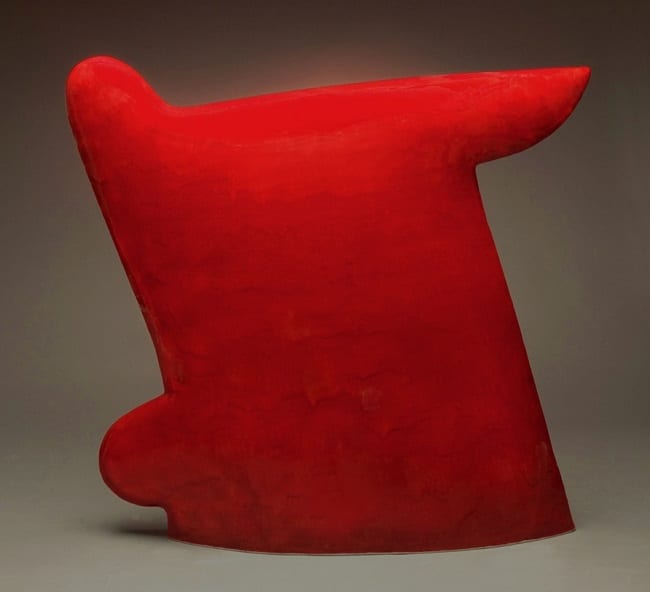James Marshall
The Endurance of Form
February 22 – March 22, 2014
William Campbell Contemporary Art
4935 Byers Ave.
Ft. Worth, Texas 76107
Opening Reception
Saturday, February 22
6:00 – 8:00 pm
Liminal— 1. of or relating to a sensory threshold 2. barely perceptible 3. of, relating to, or being an intermediate state, phase, or condition: in-between, transitional, in the liminal state between life and death.
— Webster’s Dictionary
There is a deep beauty that resides
inside of the indeterminate, the saturated
chroma, the light that radiates out into the life.
A life where everything is what it is, and
nothing is what it seems. Where color,
energy, light and form merge into one. That
is where I do my work.
— James Marshall
For nearly two decades James Mashall has explored what he calls “The Liminal Object,” fueled by minimalist aesthetics and the potential for an ordinary object to shift dimensions and space. Now he feels that this road is coming to an end. Marshall has had an intense period of working within limited parameters and putting them through the process of constant refinement and reduction.
What is interesting is at the end he is invoking the beginning. Marshall began the series with the idea that he would work only with black surfaces. There was no interest in the sculpture until he began to move more into lusciously-colored (mainly monochromatic and primary) glazes. At that point the work took off and his career has been successful. His works from this series are included in over 250 public and private collections nationally and internationally and he has been widely published in books, magazines and newspaper articles.
But now as he prepares to shift into a new landscape he decided that his last shows will be all black. Is it a funeral dress for the end of a series? Not really, “I just wanted to go back to the original concept,” he says, “and if they sell great if they don’t great. This what they need to be.” The result has been powerful and totally transformative, even though the forms are similar to previous work.
The major shift was on the surface: two matte glazes, a dense black and a pewter or gunmetal black, each occupying an area within the piece. Shift one’s attention to the red piece above (his only color work on his current exhibition) and one sees how the gloss surface softens the edge of his work, there is a haze or halo that surrounds the sculpture’s silhouette. The edge has no precise snap to it.
On the black series that line becomes sharp, crisp, emphatic and roots the sculpture in space. The play of line in the sculpture is important because his works are just this side of being two dimensional, flat sides and a very shallow area of interior volume so the impact of frontality is a key factor.
The two black glazes, slightly different in character, divide the form into two zones. (With the colored monochromatic works it is a single form.) One has the feeling of two forms that have been deliberately married. For for the viewer this simple device has doubled if not quadrupled the aesthetic complexity of the sculpture. A push-pull tension now grows between the two black glazed areas.
There is even more intrigue at the line where the glazes meet; a glow emerges as they touch each other. This is at its most exaggerated when they meet at an actual join in the form. It resembles a soldering line on a pewter vessel. In turn, it makes the material identity ambiguous, metal or clay? It has characteristics of both.
This is Marshall’s best body of work to date and if he does end his series now (one cannot always trust artists’ pronouncements) he will be ending a journey at its highest point. The work has new sculptural authority.
Marshall’s education in the ceramic arts began with a pottery apprenticeship in Guatemala while living with the Quiche, a Mayan Native American tribe during his service in the Peace Corps. He received his MFA in 1979 from the University of Michigan, Ann Arbor where he studied with John Stevenson and Rudolph Arnheim, author of Art and Visual Perception.
Marshall’s teaching experience includes the University of Michigan, Ann Arbor; the Rochester Institute of Technology, Rochester, New York; Bloomsburg University, Bloomsburg, PA.; University of Wyoming, Laramie, WY and he is currently Head of Ceramics at Santa Fe Community College. His gallery representation includes Winterowd Fine Art, Santa Fe, New Mexico; Wiliam Havu Gallery, Denver Colorado; William Campbell Contemporary Art, Ft. Worth, TX; Aberson Projects, Tulsa, OK and Bentley Galleries, Scottsdale, AZ.
Garth Clark is the Chief Editor of CFile.
Above image: James Marshall, RED #387, 2014, glazed ceramic 33″H x 37″W x 6.5″D

James Marshall, BLACK #396, 2014, glazed ceramic, 33″H x 38″W x 6″D

James Marshall, BLACK #397, 2014, glazed ceramic, 33″H x 38″W x 7″D

James Marshall, BLACK #395, 2014, glazed ceramic 33″H x38″W x 6″D

James Marshall, BLACK #399, 2014, glazed ceramic, 33″H x 38″W x 6″D

James Marshall, BLACK #398, 2014, glazed ceramic, 33″H x 38″W x 6″D

James Marshall

Great pieces! Here are suggested titles
1. Cyrano Looking Up with Muffle
2. Knight with High Speed Affect
3. Survived Shark
4. Cyrano with Directional Fin
5. Up There!
6. See How Ears Get Bigger
Hi, Garth;
Thanks so much for the great review of James’ work! We are so pleased to represent James and have a stunning exhibition currently that includes some of the works you’ve illustrated here!
Best regards,
Pam Campbell
William Campbell Contemporary Art